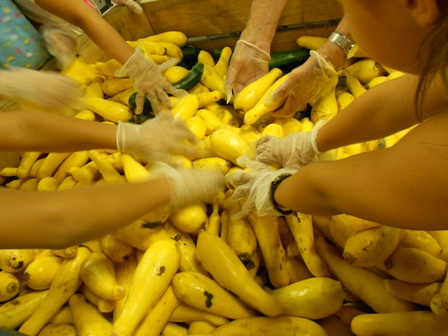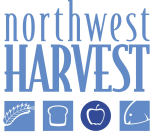Volunteer Specifics
If in a gleaning in an orchard, most of the fruit will likely be in clusters only accessible by ladder, but some should still be accessible from the ground. Most groups or individuals participating in gleaning will come out for a few gleans and training in the field is much easier than inside. Here are some tips about in field training on specific topics.
Picking bags
Volunteers will need to be advised on how to put on a picking bag because most have never used one before. Also be sure to inform them of how the bottom of the bag is tied, specific to the style of bag. Another important thing to share is how to release the fruit from the metal holding mechanism. Encourage volunteers to release fruit gently into the bin to prevent bruising and damage to the fruit. Gentle handling is especially important for very soft fruit such as peaches, plums, or very ripe pears.
 Ladders
Ladders
This is a very important topic to discuss with volunteers because ladders are one key piece of equipment which if not used correctly could result in injury. Most volunteers have not used an orchard ladder before so good field training on use is extremely helpful. Teach volunteers how to set a ladder correctly. Teach them specific ladder use safety such as ensuring that while on the ladder the users “belt buckle” remains within the outer rungs of the ladder at all times. This will ensure that when volunteers are at the top of the ladder they will stay on the ladder, and stay balanced. Sharing tips and tricks to setting up a ladder to reach more fruit is also extremely beneficial.
A tool that is helpful to learn more about ladder safety is a video called “Tripod Ladder Safety” by Washington State Dept. of Labor and Industries in 2008. You can view a copy of the video from WA Labor and Industries through their resource library. Registration is free, and several video resources can be sent to you. They only cost would be in returning the video. It is also available on YouTube. The video is targeted towards professional pickers in the commercial fruit business, but the information about using a ladder is extremely helpful for a gleaning coordinator to gain the knowledge to teach ladder etiquette to volunteers.
Picking
Sharing picking knowledge is important because volunteers who might not know any better could potentially destroy next year’s crop by breaking off the spurs. There is lots of information on the internet about how to pick different types of produce, and reading some of that can be beneficial: Harvesting and Storing Apples and Pears The best thing to do is ask the producer. They know how it should be picked, and usually know extremely efficient tricks to help pick more fruit faster, such as cupping your hands around a whole bunch of blueberries and pulling them off in your hands all together as opposed to picking one berry at a time. Quality control is also important, even more so when picking into boxes, and standards should be shared with volunteers to ensure what you consider good product goes into boxes or bins. Keep in mind if you’re picking into bins the produce will most likely be resorted and repacked, but fruit in boxes will go directly to food banks and clients.
Other Details
If using boxes, especially if they are a unique style, be sure to let the entire group know how to put them together and close them. Be sure to let volunteers know where full boxes go, and ensure you are on the same page with chaperones if they are present. Sometimes chaperones act like they know more than you do, so be sure to take a moment after the volunteers start picking to emphasize details so everyone is clear about directions.
Weather
If it’s calling for rain or wind keep several things in mind. If it rains the night before a glean or the day of, trees will be wet. Water will come down on pickers when in the trees: the volunteers will be wet, and eventually cold. Depending on how the rest of the day goes, you might want to end early to be sure your volunteers don’t get sick. Second, water on the ground and trees will eventually make the ladders very slippery; make sure you inform the volunteers! Ladders can be hazardous, and if they are wet it can quickly become dangerous if volunteers are not careful. Finally, some fruit act different after a rain. Cherries, depending on how sudden the introduction of water from a heavy rain might tear, which is called rain cracking. Golden Delicious apples will bruise easier than normal when picked right after a good rain and pears will ripen faster. These are just a few examples of fruit idiosyncrasies, and it’s good to talk with producers about weather if rain is in the forecast. Also, growers or the master gardeners group in your community are a good source for local information on how weather affects local produce.
Produce Logistics
 Logistics are different when picking into boxes verses bins. Packing gleaned produce directly into boxes is generally easier, depending on how much there is to harvest. If picking into bins, they should be dropped off at least a day in advance. If your organization has bins it makes life easier; if not, try to track down lightly used ones for donation. The producer you’re picking from might have some extras you can borrow. If not, and you know a larger producer in the area, call them and ask to borrow some. The key to borrowing bins is to ensure you get the correct bins back to the right producer. Figure out before the glean how to move the full bins in the field. Ask the producer if they have a tractor or forklift because it’s absolutely critical to have one. Also, pallet jacks don’t work on dirt, so moving bins and loading them into the truck will be very difficult without a tractor or forklift. If the producer does not have a way to move bins and you don’t either then you must use boxes no matter how much you are picking. Finally, it is important to find out how many bins your truck can handle. Depending on how many full bins you have, it might take several trips to get all the fruit out of the field.
Logistics are different when picking into boxes verses bins. Packing gleaned produce directly into boxes is generally easier, depending on how much there is to harvest. If picking into bins, they should be dropped off at least a day in advance. If your organization has bins it makes life easier; if not, try to track down lightly used ones for donation. The producer you’re picking from might have some extras you can borrow. If not, and you know a larger producer in the area, call them and ask to borrow some. The key to borrowing bins is to ensure you get the correct bins back to the right producer. Figure out before the glean how to move the full bins in the field. Ask the producer if they have a tractor or forklift because it’s absolutely critical to have one. Also, pallet jacks don’t work on dirt, so moving bins and loading them into the truck will be very difficult without a tractor or forklift. If the producer does not have a way to move bins and you don’t either then you must use boxes no matter how much you are picking. Finally, it is important to find out how many bins your truck can handle. Depending on how many full bins you have, it might take several trips to get all the fruit out of the field.

 Ladders
Ladders Logistics are different when picking into boxes verses bins. Packing gleaned produce directly into boxes is generally easier, depending on how much there is to harvest. If picking into bins, they should be dropped off at least a day in advance. If your organization has bins it makes life easier; if not, try to track down lightly used ones for donation. The producer you’re picking from might have some extras you can borrow. If not, and you know a larger producer in the area, call them and ask to borrow some. The key to borrowing bins is to ensure you get the correct bins back to the right producer. Figure out before the glean how to move the full bins in the field. Ask the producer if they have a tractor or forklift because it’s absolutely critical to have one. Also, pallet jacks don’t work on dirt, so moving bins and loading them into the truck will be very difficult without a tractor or forklift. If the producer does not have a way to move bins and you don’t either then you must use boxes no matter how much you are picking. Finally, it is important to find out how many bins your truck can handle. Depending on how many full bins you have, it might take several trips to get all the fruit out of the field.
Logistics are different when picking into boxes verses bins. Packing gleaned produce directly into boxes is generally easier, depending on how much there is to harvest. If picking into bins, they should be dropped off at least a day in advance. If your organization has bins it makes life easier; if not, try to track down lightly used ones for donation. The producer you’re picking from might have some extras you can borrow. If not, and you know a larger producer in the area, call them and ask to borrow some. The key to borrowing bins is to ensure you get the correct bins back to the right producer. Figure out before the glean how to move the full bins in the field. Ask the producer if they have a tractor or forklift because it’s absolutely critical to have one. Also, pallet jacks don’t work on dirt, so moving bins and loading them into the truck will be very difficult without a tractor or forklift. If the producer does not have a way to move bins and you don’t either then you must use boxes no matter how much you are picking. Finally, it is important to find out how many bins your truck can handle. Depending on how many full bins you have, it might take several trips to get all the fruit out of the field. 